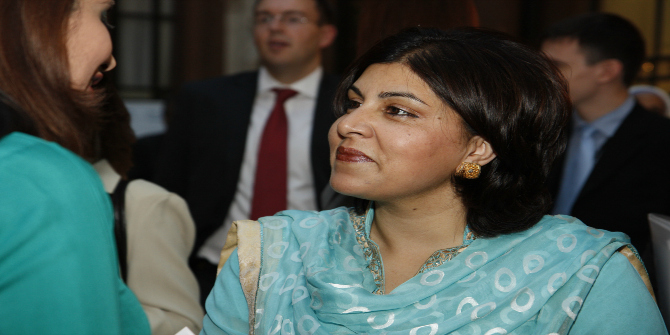Rediscovering Voluntary Action aims to present a radical reappraisal of voluntary sector theory and practice over the past thirty-five years, restating the distinctive nature and autonomous status of voluntary action in British society. This book is valuable and informative as it raises important questions about the larger purpose and meaning of voluntary action in society, and challenges the dominant thinking which has focused on the voluntary sector and voluntary action in terms of policy impact and its role and effectiveness in delivering services, writes Armine Ishkanian. A useful resource for scholars, students, practitioners, and policy-makers who are interested in understanding voluntary action and civil society in Britain.
 Rediscovering Voluntary Action: The Beat of a Different Drum. Colin Rochester. Palgrave Macmillan. December 2013.
Rediscovering Voluntary Action: The Beat of a Different Drum. Colin Rochester. Palgrave Macmillan. December 2013.
Rediscovering Voluntary Action: The Beat of a Different Drum by Colin Rochester makes an important contribution to studies of voluntary action in Britain and to current public debates about the aims and role of the voluntary sector in society (e.g., Big Society, localism agenda, the ‘gagging law’ etc.). Rochester draws on his extensive experience of working with voluntary organisations as a researcher and practitioner to ‘rethink’ both the theory and practice of voluntary action.
His central argument is that both the theory and practice of voluntary action are constrained by two “narrow paradigms” which set the boundaries for the ways in which we look at voluntary organisations and volunteering. According to Rochester, the first paradigm is the voluntary sector paradigm, which has shaped research such that most studies focus on voluntary action that is formally constituted (i.e., professionally managed agencies with hierarchical structures), whereas the second, the dominant paradigm, characterises volunteering as “gift of time” viewing it as analogous to a “gift of money”, and views this activity as “unpaid work that needs to be managed” (p. 7). Throughout the book Rochester critiques and challenges these dominant paradigms and concludes by developing an alternative paradigm which involves restructuring the research agenda and changing current practices.
The book begins with an Introduction followed by 16 chapters that are divided into the following four parts: “Context”, “Pressures & Influences”, “Alternative Perspectives”, and “Conclusion & Implications”. In the first chapter in Part I, Rochester revisits the history and roots of voluntary action and how it has developed over time. In addition to discussing the development of philanthropy from the 16th century to the present or what he calls the ‘impulse from above’, Rochester also examines how mutual aid, or the ‘impulse from below’, has developed since the Middle Ages. The chapter makes an important contribution to the study of the history of voluntary action by also focusing on campaigning and voluntary action for social change and social justice, which has not, as Rochester points out, received the same level of scholarly attention as studies of philanthropy and mutual aid. By examining the ‘road less travelled’, Rochester discusses the historical involvement of voluntary organisations in campaigning and (non-party) political activities and maintains that such accounts are important if we are to have a fuller picture of the variety of organisational forms and ways in which people and groups interact and their relationships with the state (p. 34). In the remaining two chapters in Part I, he examines the “invention” of the voluntary sector and voluntary work respectively and the implications these social constructs or “inventions” have had on the identity and independence of voluntary organisations (Chapter 3) and how volunteering is perceived, discussed and promoted (Chapter 4).
In a number of chapters in Part II, “Pressures and Influences”, Rochester considers how increasing closeness with both the state and market hold opportunities for the sector, but also hold dangers including the loss of the ability to pursue new ways of addressing need. Drawing on David Billis’ ‘worlds’ theory and work on hybridisation, Rochester critically analyses the “hegemony of the bureaucratic model” (Chapter 7). He argues that the bureaucratic model does not provide an adequate theory for understanding how many voluntary organisations are structured and function (p. 110) and that much of the research on voluntary organisations, which embraces this model, does not recognise the complexity of the organisational landscape instead focusing on a narrow subset of voluntary organisations, namely large, professionalised charities.

The chapters which follow in Part III, “Alternative Perspectives”, can be considered the heart and soul of the book. In these chapters Rochester tackles the question “what is the role or function of voluntary action in our society and why does it matter?” (p. 147). In answering this question Rochester challenges the instrumentalist view of voluntary action which postulates that voluntary organisations exist to deliver services or activities and that success should be measured by how effectively and efficiently they achieve those objectives. He argues that such a view ignores that for many people engaged in voluntary action, participation meets expressive needs and that these activities have intrinsic value that are “ends in themselves rather than the means to some external impact” (p. 148). Moreover, he examines the role of voluntary organisations as “mediating institutions” in which individuals can share in and contribute to meaningful association. From this point of view, voluntary action becomes more than a vehicle for addressing social problems and delivering services and plays a vital role “in social integration and the political process” (p. 160).
In Chapter 13, “Dissenting Voices”, Rochester moves from the theoretical discussion to examine two specific cases: the National Coalition for Independent Action (NCIA), and the initiative by the Baring Foundation’s Strengthening the Voluntary Sector programme to create an Independence Panel to monitor the state of sector independence. While he discusses the significance of the work of the Independence Panel, the bulk of the chapter is dedicated to a discussion of the NCIA, which Rochester calls the “most active and least compromising of the critics of current trends” (p. 189). The NCIA, which has its roots in the “‘bottom-up’ self-help tradition” (p. 194), was founded in 2006 by people with substantial experience of working with voluntary organisations who expressed concern and opposition to ever-growing bureaucratisation. While recognising NCIA’s achievements, which include taking the debate about independence to the mainstream and creating alliances and a national network of contacts (p. 200), Rochester argues that it has not halted the “juggernaut of state and private sector hegemony” and that there is no “serious rebellion in the sector against those who have led it into ‘partnership’ with the state” (p. 201). Rochester considers why there has been a lack of response from practitioners and argues that it could be that this intervention has come too late and the damage to the independence of action has gone too far to be reversed. Based on my own research on voluntary action in the UK, I very much agree with Rochester’s arguments and analysis. However, I also wonder whether the lack of “rebellion” against the loss of independence is not also due to the fact that for some practitioners, partnership with the state and closeness to policy makers, are desirable objectives and strategic aims?
Rochester concludes by moving on to the development of an alternative paradigm for research and action. In doing so, he provides useful recommendations for researchers and practitioners (Chapter 16). One criticism I have is that Rochester does not engage more with broader theories of civil society in his analysis, and this seems a missed opportunity. That said I found this book valuable and informative because it raises important questions about the larger purpose and meaning of voluntary action in society, and challenges the dominant thinking which has focused on the voluntary sector and voluntary action in terms of policy impact and its role and effectiveness in delivering services. I believe this book will be a useful resource for scholars, students, practitioners, and policy-makers who are interested in understanding voluntary action and civil society in Britain.
———————————–
Dr Armine Ishkanian is the Programme Director of the MSc in NGOs & Development, LSE Department of Social Policy. She is the author of Democracy building and civil society in post-Soviet Armenia (2008 Routledge, London), The Big Society Debate: A New Agenda for Social Welfare? (May 2012 together with Simon Szreter; Edward Elgar Publishers) and numerous academic journal articles. Her research examines the relationship between civil society and social transformation as well as how civil society organisations and social movements engage in policy processes. Read more reviews by Armine.







